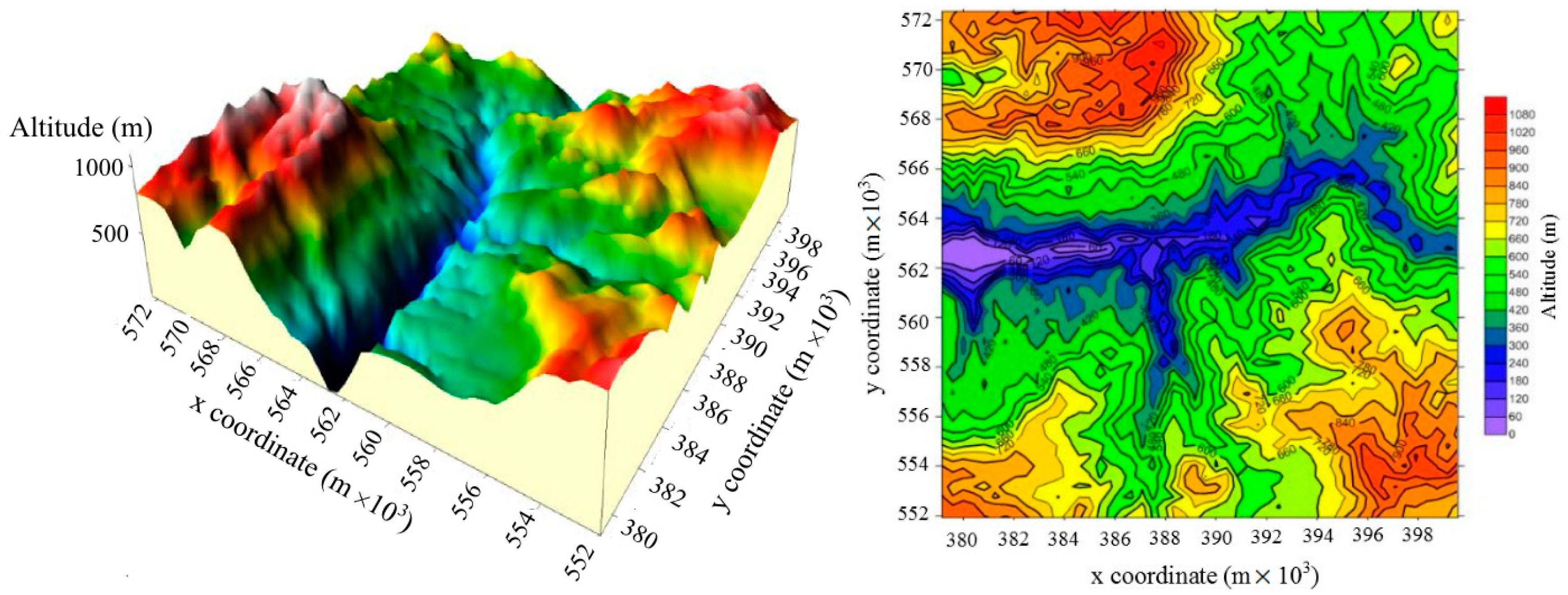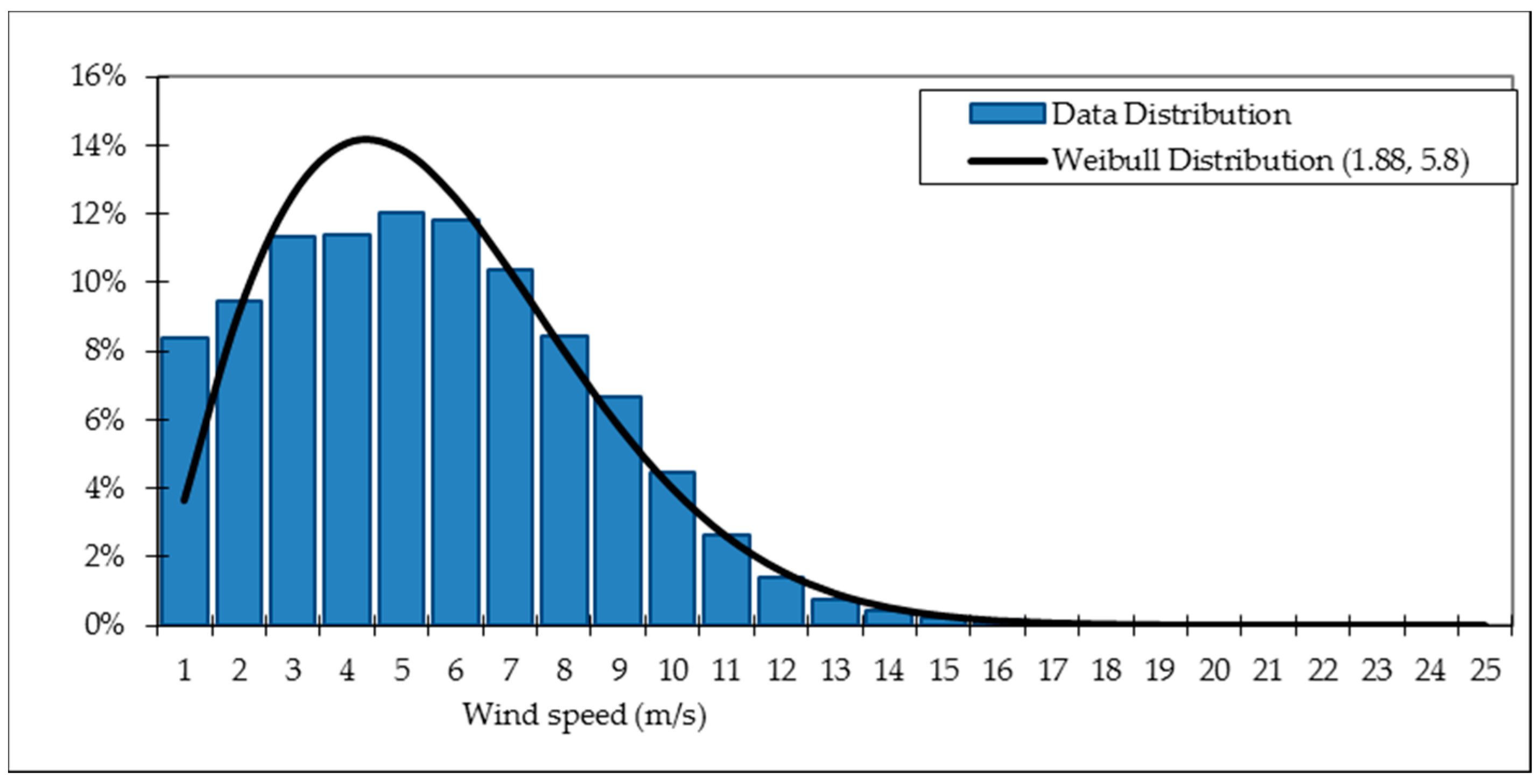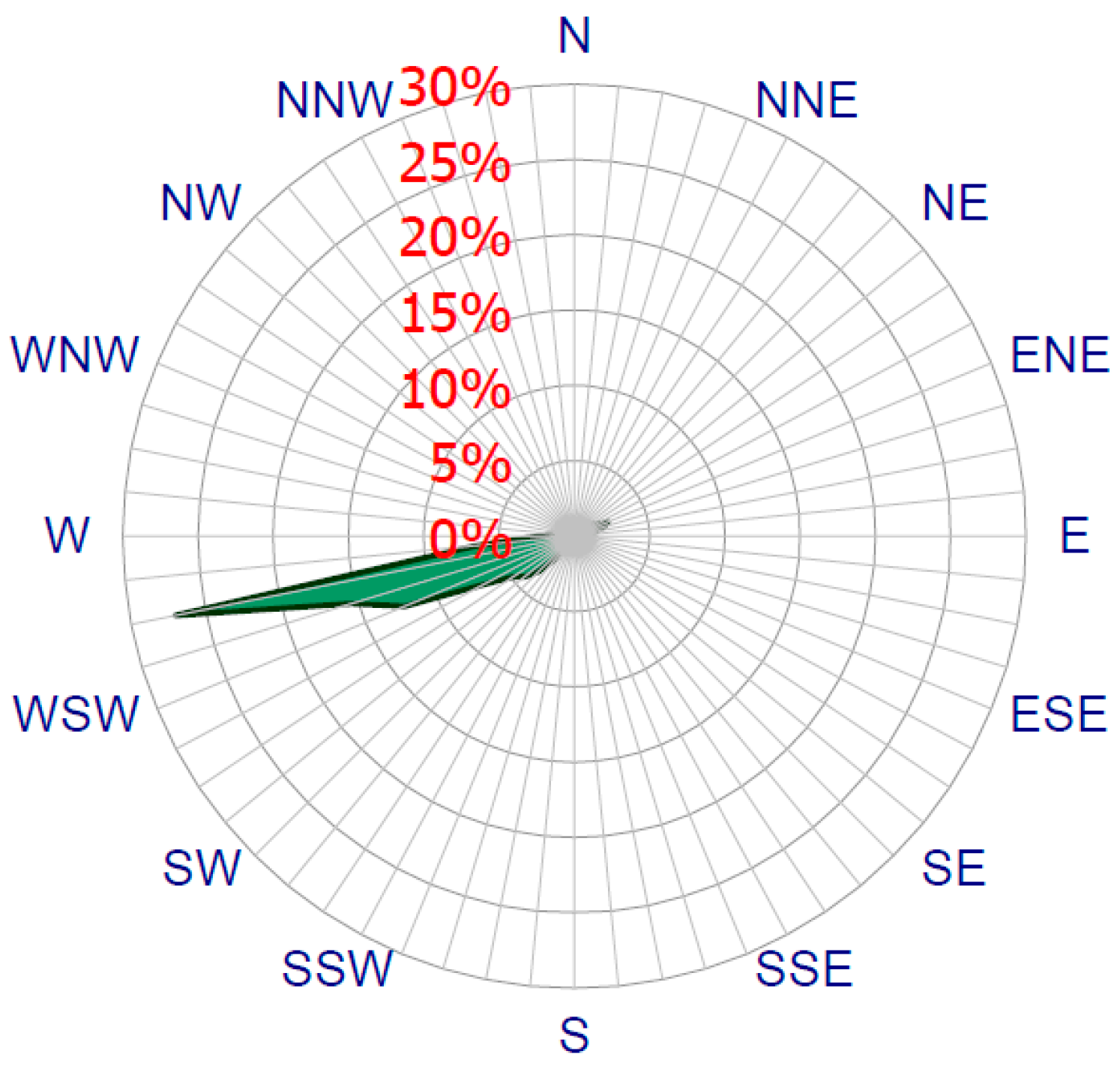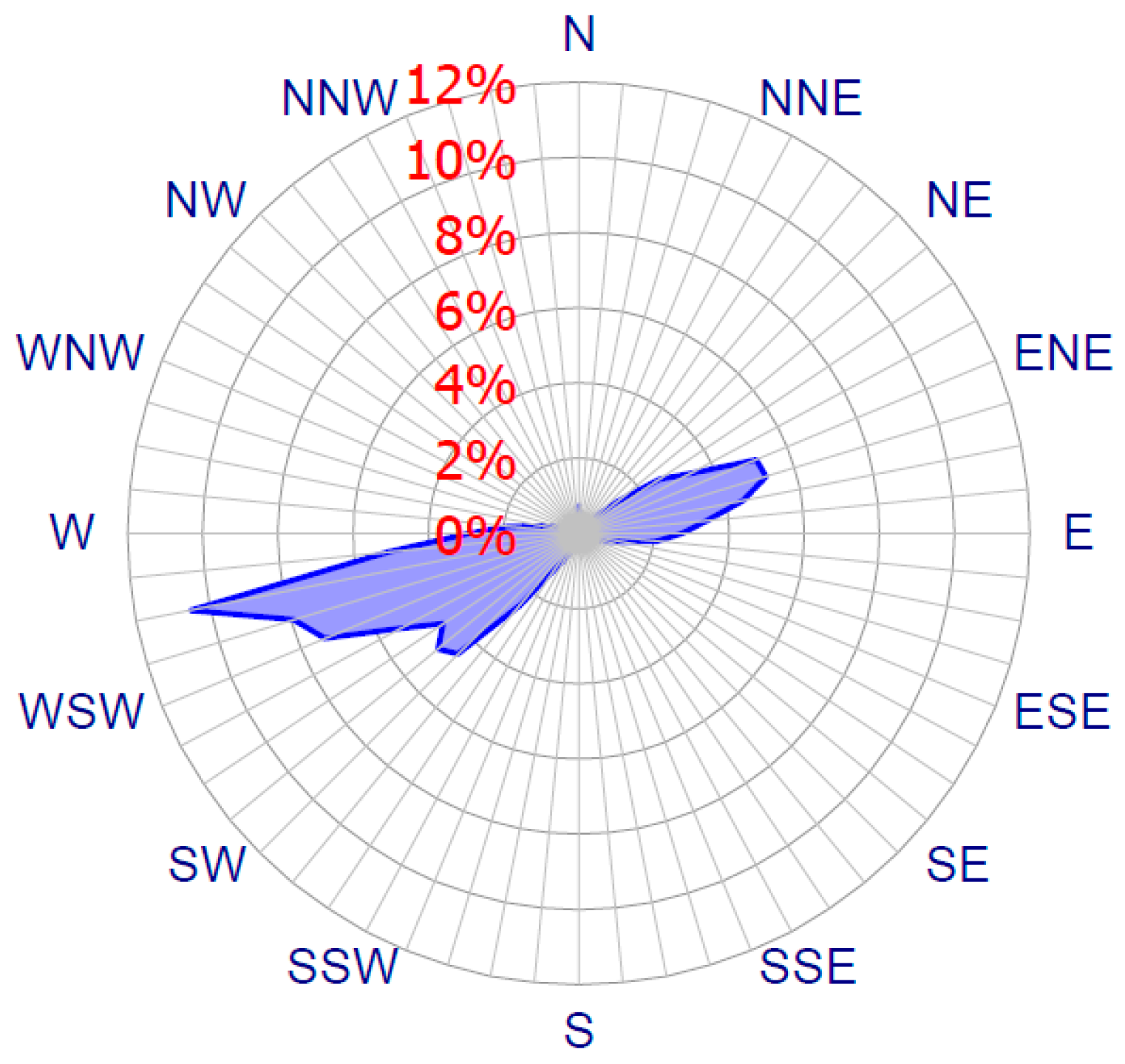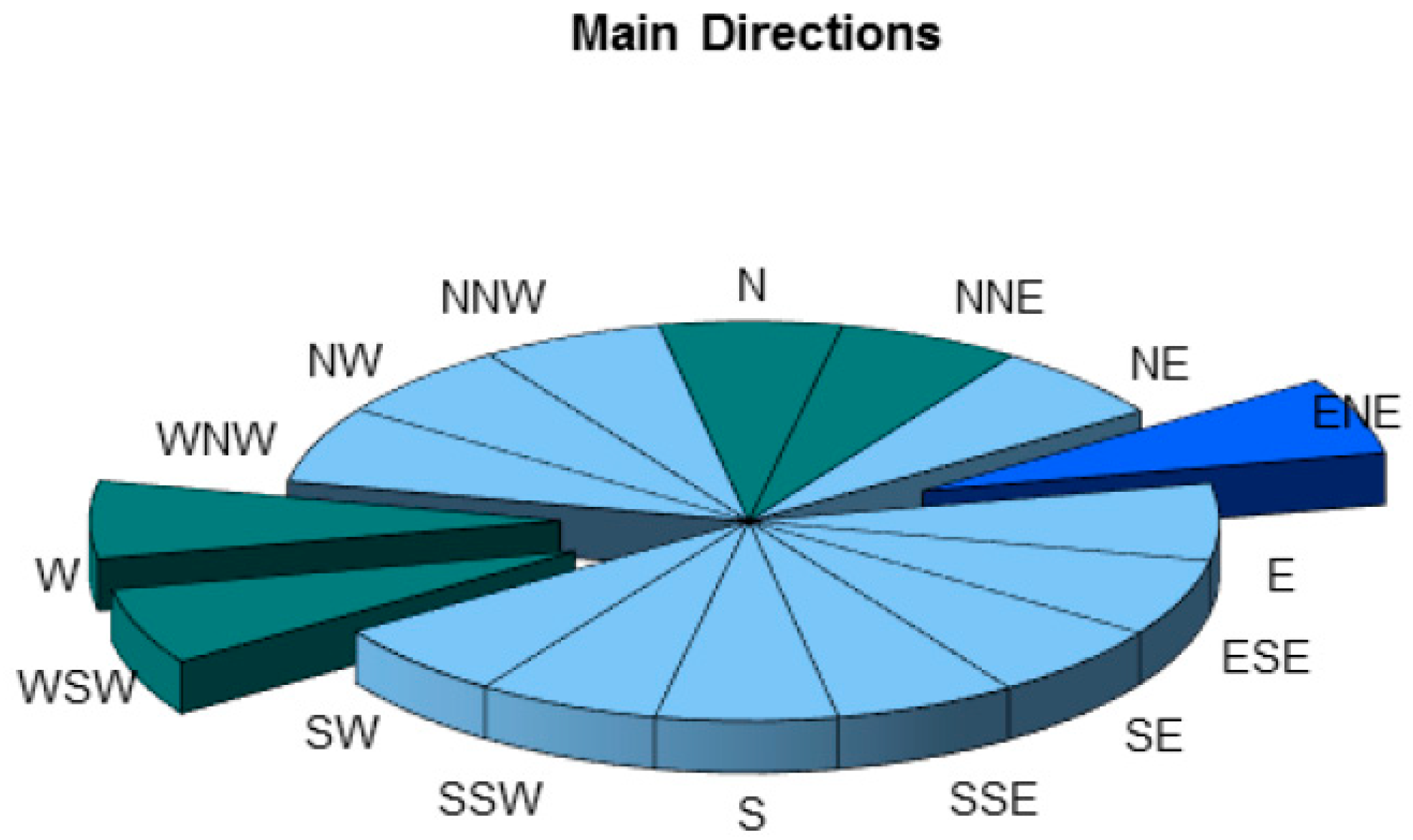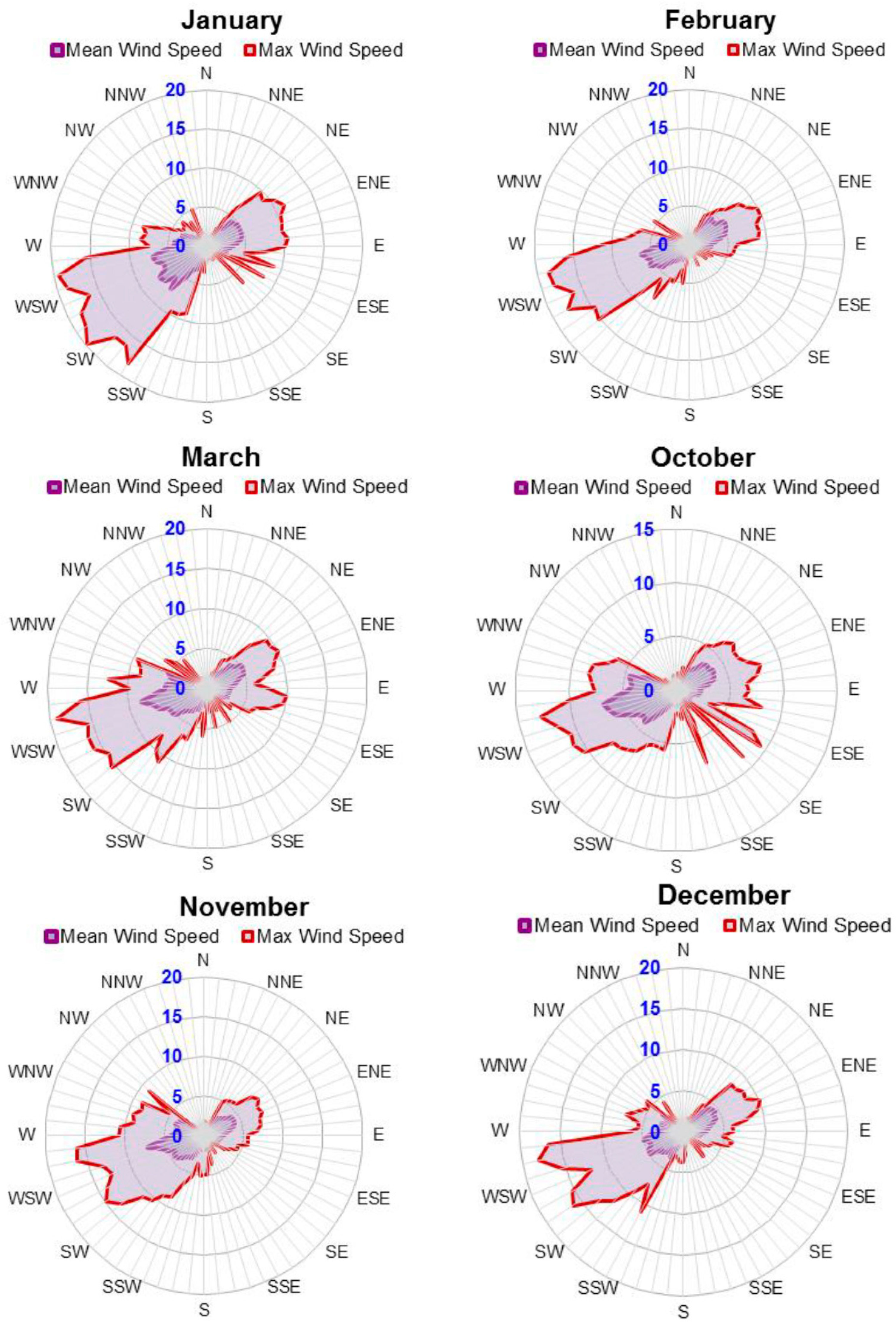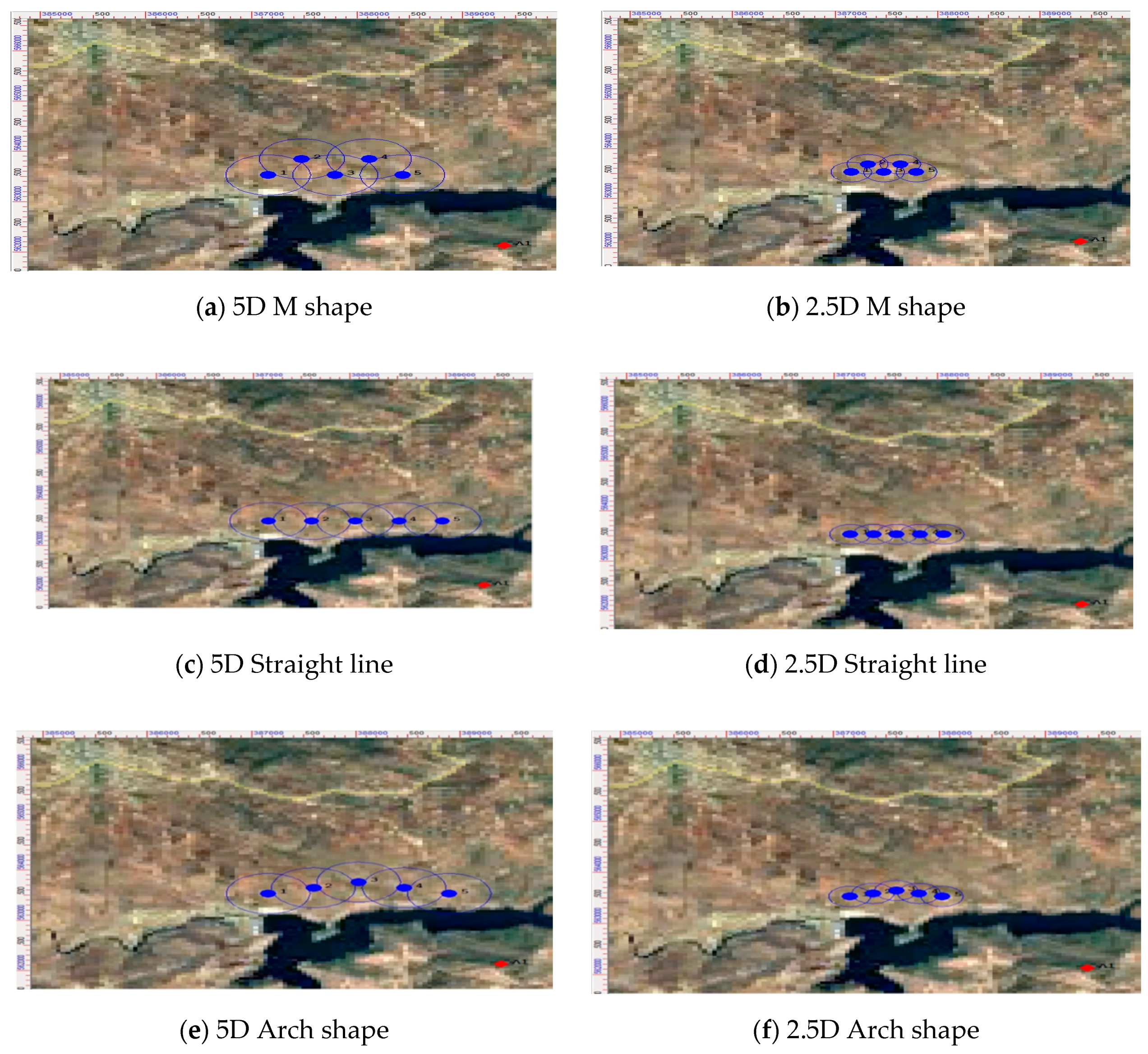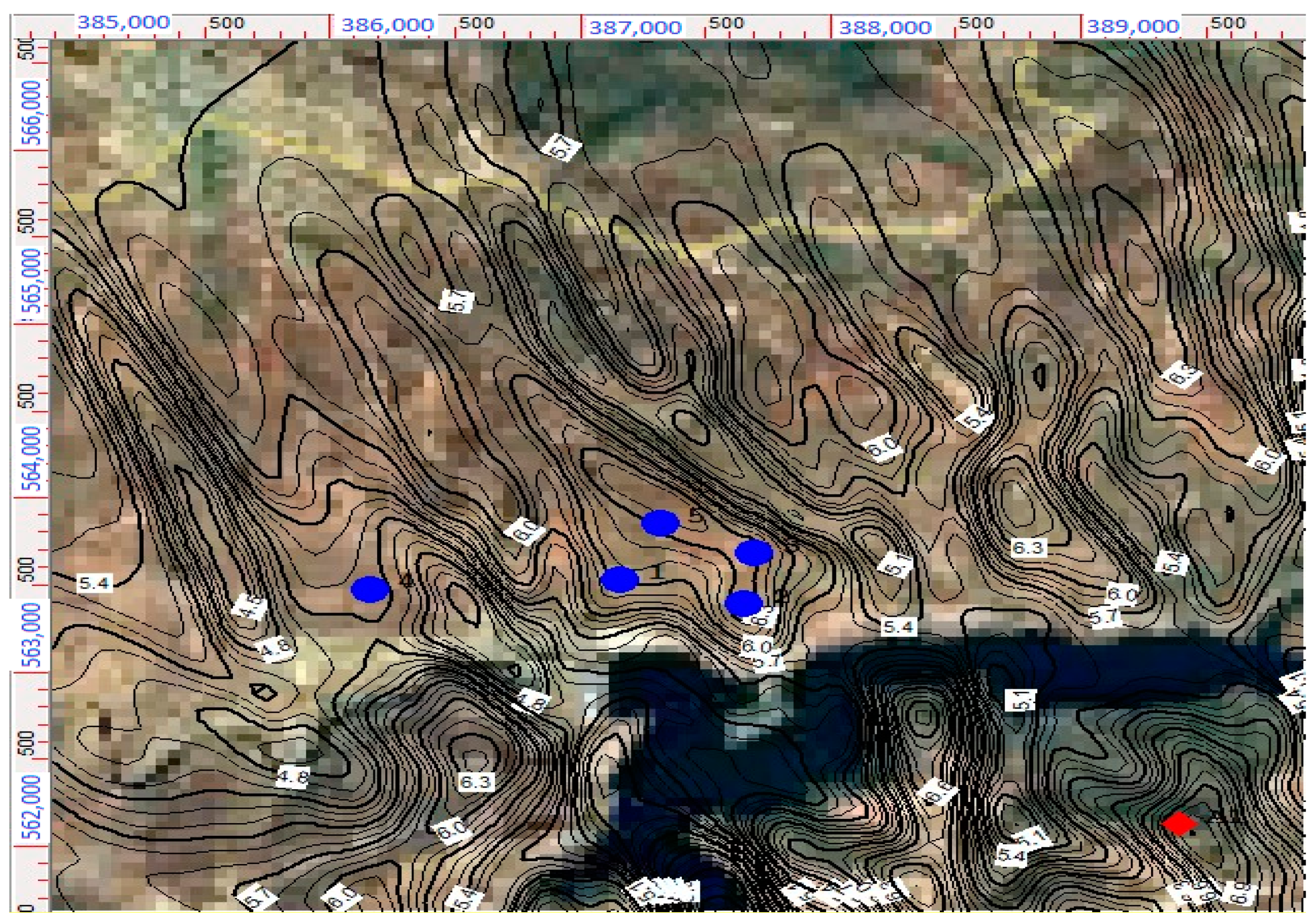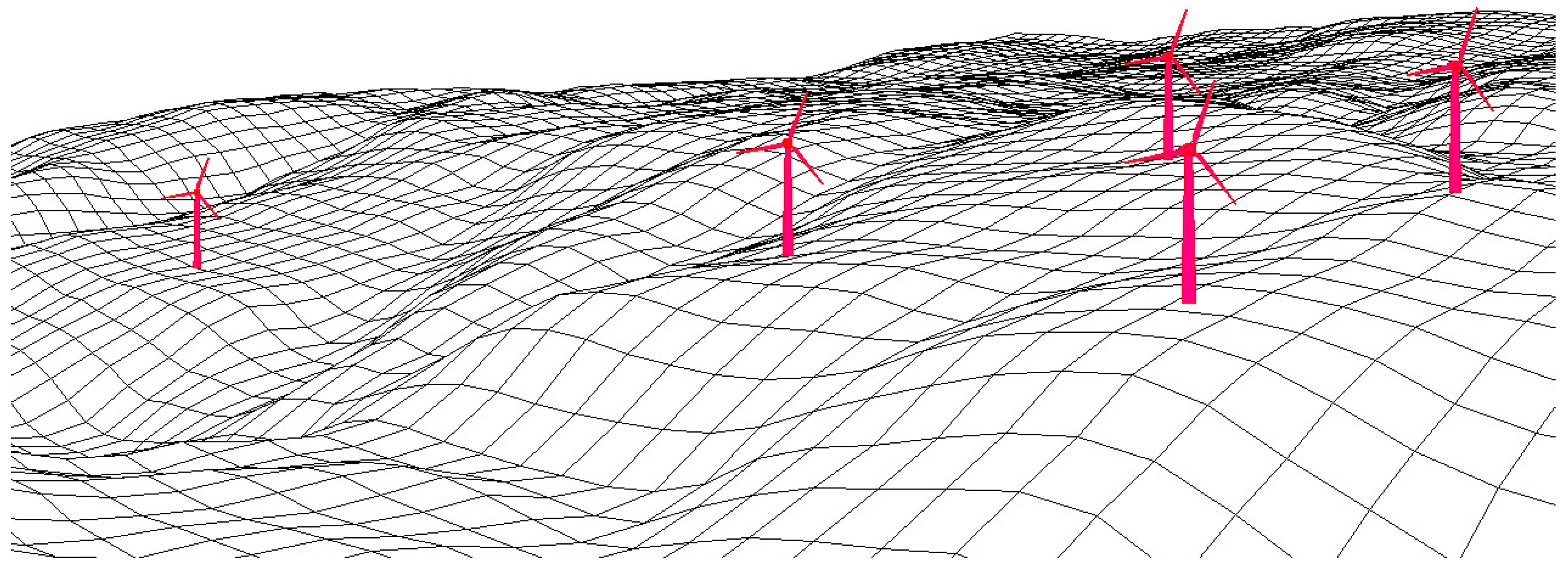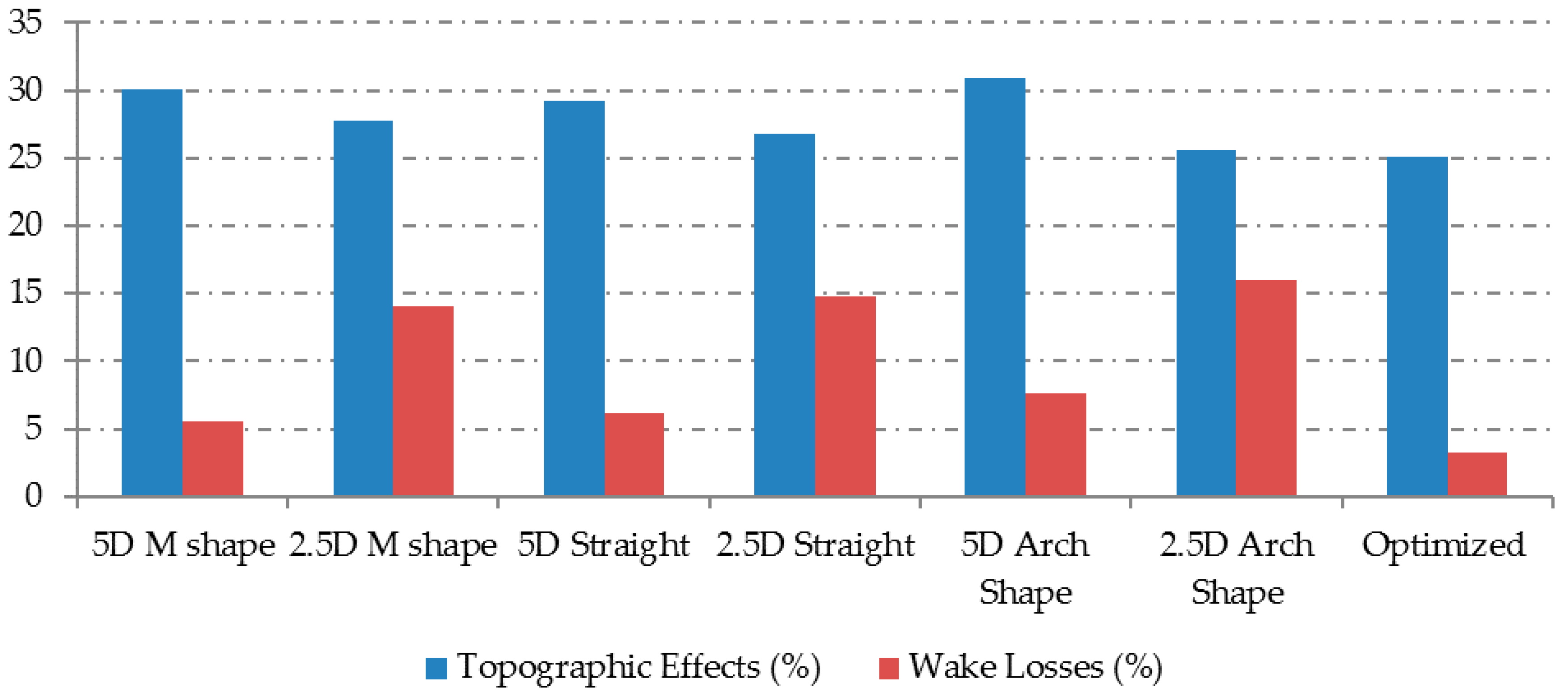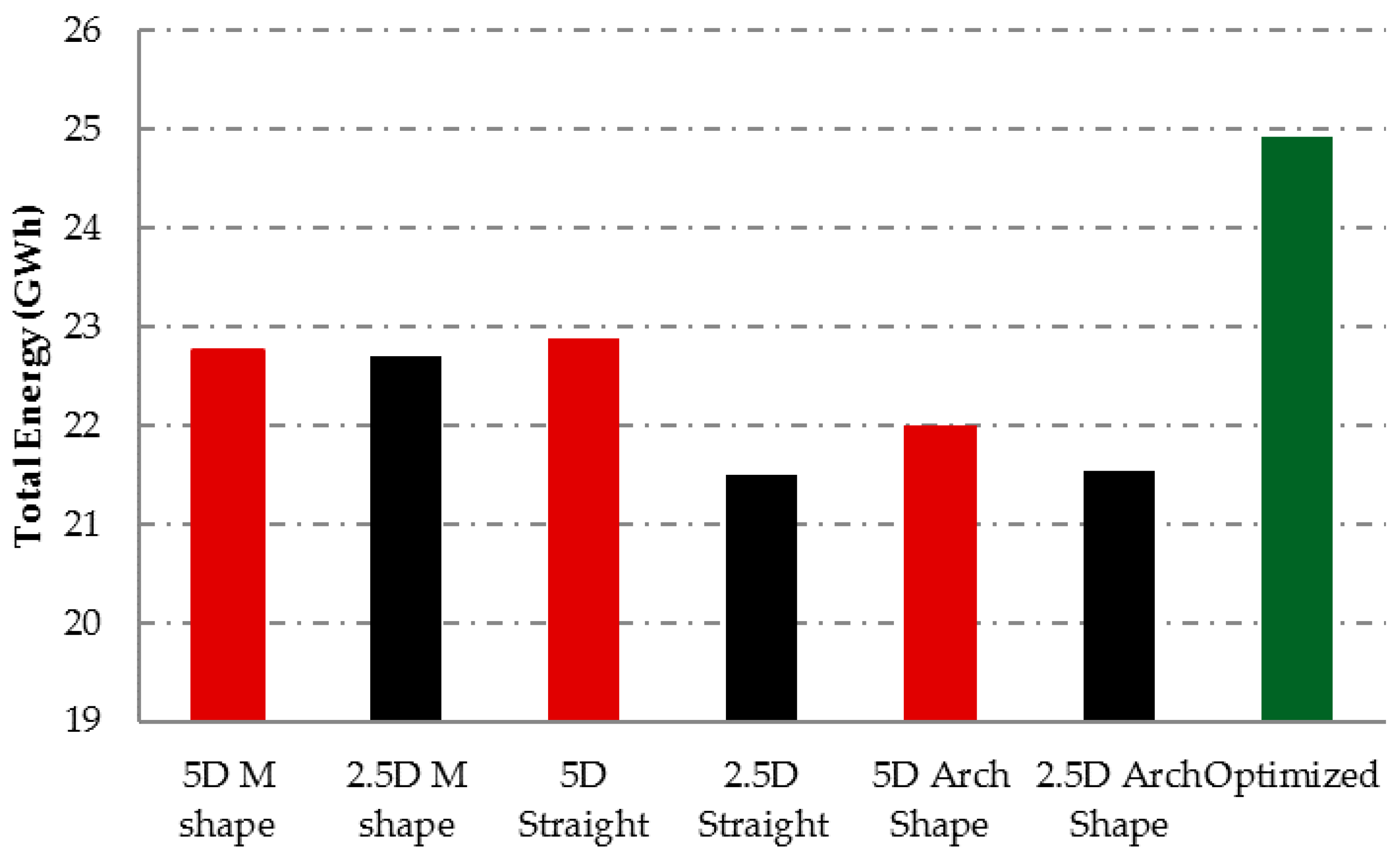1. Introduction
Nowadays, wind turbines are usually installed in so-called wind farms. For space and cost reasons, the wind turbines should be as close as possible to each other, but not mutually influence each other. To avoid mutual interference, the wind turbines need to be arranged in a layout according to the prevailing wind direction, in order to harvest the maximum energy [
1].
There are several criteria which have been considered for the selection of a site for a largescale wind energy farm, such as annual average wind speed, main direction and energy generation. Also, other factors are considered that depend upon the site selection, such as local infrastructure, soil composition and availability of electrical network.
Wind turbines can be adapted to meteorological conditions due to their aerodynamic shape. In order to take the site conditions into account, the potential location of a wind turbine must be examined in advance. For the selection of suitable locations, numerical simulations are mostly used which examine the meteorological and orographic conditions in advance. The wake flow has effects on the environment, and in particular on the wind field of other wind turbines.
These effects of turbulent wake flow on meteorological sizes have been investigated with numerical simulations by Prósper et al. [
2], Astolfi et al. [
3] and Han et al. [
4]. However, computer models can only be an approximation of nature, since the simulations are always subject to uncertainties. For each application an estimation of the representation of the relevant processes must be made. For processes that cannot be mapped, parameterizations need to be found. The different ways to model wind turbines depend upon the physics of the models, the used parameters and the objective of the study. The model and the parameterization must be selected according to the examination objective. Thus, very high-resolution models can calculate the aerodynamics of the rotor blade, but due to the numerical effort, they are not able to simulate the flow and wake-up flow over a larger area than in the immediate vicinity of the turbine. However, if the turbulent wake flows of a wind turbine or even an entire wind farm should be considered, a much coarser area must be used to capture the area of interest.
One of the main issues in designing an optimized wind farm layout is the definition of the optimal location of each single turbine, while simultaneously considering the avoidance of wake losses under certain restrictions like the topographic, land availability and the prominent wind direction. This issue has been examined in many recent studies using different optimization algorithms [
5]. Wind farm turbines’ layout optimization and wake steering should correspond, since substantial annual energy generation enhancements can be obtained by wake steering in a wind farm layout that is optimized to minimize wake losses [
6].
Several studies have developed mathematical models to optimize the wind turbine arrangement in the wind plant. Genetic algorithms have been applied to optimize the placement of wind turbines such as in Mosetti et al. [
7], Grady, et al. [
8], Ju et al. [
9] and Brogna et al. [
10], also by applying Monte Carlo simulation like in Wang et al. [
11] and Marmidis et al. [
12]. In a previous study, a new mathematical model has been developed to optimize the wind turbine arrangement in the wind farm. The new optimization method is based on numerical simulations focusing upon maximizing the total electricity generation of the wind farm. The results have shown significant improvements in wind farm power generation reaching up to 6% compared to other methods like genetic algorithms [
13].
A Gaussian wake model has been applied in other studies to find the optimal layout for a wind farm [
14]. The results have shown that the use of genetic algorithms can reduce annual maintenance costs and increase the efficiency of a wind farm in different scenarios [
14].
Other studies have been carried out to solve the problem of wind farm layout optimization by developing new mathematical programming. By applying the new model to several previous layouts, it has been shown that these optimized layouts could generate extra energy with a higher symmetric layout [
15].
Another study has analyzed the effect of wind turbine layout on the energy generation from the wind farm [
16]. This research compared regular layouts to micro-siting models based on the energy output. The results have shown that the micro-siting model array shows higher conversion rate than the aligned and staggered layouts by 4.09% and 2.18%, respectively [
16].
For the purpose of reaching the maximum wind energy generation, other studies have been developed to optimize the wind farm layout. In the research of [
17], there has been designed a model based on parameters like wind distribution, wake loss and wind direction. The model results show significant improvements in energy generation compared to a regular layout without optimization.
Furthermore, some more related studies have optimized the wind farm layout using a three-dimensional model depending on the so-called “greedy” algorithm. The numerical method applied is based on multiple hub heights to maximize the energy output and minimize the cost. Compared to layouts created by the genetic algorithm and identical hub height, the proposed greedy algorithm shows lower computational requirements and better results [
18].
The 2D Jensen–Gaussian wake model or Jensen’s wake model have been used as genetic algorithm wind farm turbines layout optimization programs, where recent studies indicate that the significance of the 2D Jensen–Gaussian wake model means more theoretical importance and real data in wind energy operation [
19].
For the wind speed fluctuations, various statistical methods have been applied [
20], where the Weibull distribution is most commonly used. The wind direction variation is typically presented in a wind rose diagram. Merging these two, the recorded wind data can be built into sector-wise Weibull distributions, which can be used for wind resource assessment and annual energy yield calculations. The wind modeling techniques have been implemented in different studies on wind farm layout optimization. In order to perform the analysis, the compass is divided into 12 sectors, each one representing 30 degrees of the horizon. A wind rose may also be drawn for 8 or 16 sectors, but a 12 sector layout tends to be the standard set by the European Wind Atlas, where some studies used 12 sectors for wind direction such as in Dobrić et al. [
21] and Rivas et al. [
22], while others used 24 sectors [
23].
However, there is a need of more optimization techniques to optimize wind farm layout for harvesting the maximum possible energy, and in recent years more developments have been done for a better arrangement of wind turbines in larger wind farms [
24].
In this research, a wind farm with five turbines located in Jerash in Jordan, has been designed and analyzed. The analyses are carried out using the WindFarm software to examine the significance of wind turbines’ layouts (M, straight and arch shapes) and spacing on the final energy yield.
2. Description of the Site
In this research, the examined wind farm is located in the Umm Al Rumman hill, Jerash, Jordan. The used wind data from the site has been collected by a meteorological station, which is located 2 km in linear distance from the study location. The hill has low, sparse vegetation, and is accessible by a small service road. However, it can be considered as a suitable location for a wind farm, as there are no obstacles or residential areas around. From an environmental point of view, the site is not considered as a protected nor a military area. The topography data for the wind farm location in meters is shown in
Figure 1. The site is characterized by a valley in orientated directions. Furthermore, there are strong height differences of more than 800 m, creating an influence of the wind emergence on the downhill sides. The valley acts here like a funnel, concentrating the wind and increasing the velocity to allow an economical use of the wind.
Considering all given conditions and the topography of the site, a desired wind farm size of 10 MW shall be optimized. The proposed wind farm consists of five wind turbines with a design capacity of 2 MW each. In order to evaluate the local wind potential (mainly wind speed and wind direction) for long term wind conditions of the site, raw data from the nearest meteorological mast has been used. The first step is the determination of the exact location of the wind park and the specific topography of the open area of the wind farm, and the influence on wind velocity and directions. This step is performed by a site analysis in the WindFarm Software described in
Section 3. Then, the topography data for the wind farm location and the transformation factors of the coordinates in Jordan (Central Meridian, origin latitude, scale factor, false easting and northing) have been applied in the Mensuration Services Program (MSP) Geographic Translator (GEOTRANS, Version 3.4) [
25].
3. Methodology
3.1. Wind Data
For this research, there are 52,704 data sets available which have been recorded during one full year. They are represented in 10-min readings, taking into account that the year 2008 was a leap year. However, the total valid data during the measurement period is lowered to 49,098 data sets during 340.95 days of the year, while the calm wind speed, measuring less than 2 m/s, is 0%. The missing data in the examined time frame is 3605 samples representing 6.8% from all samples.
In order to identify the suitable site of the wind farm, and to analyze the wind potential of the wind farm location, the measured wind speeds and their directions for at least one calendar year should be analyzed.
In order to evaluate the local wind potential for long term wind conditions area, the raw data of wind speed and direction from the meteorological weather station which has been installed in Um Al Rumman have been used. The station is located within the latitude and longitude of 32°10′56.0′′ N and 35°49′36.1′′ E. The data set collected has been recorded from 1 July 2007 until 30 June 2008, and its sampling rate is one sample per second. The data acquisition system calculates 10 min averaged values, along with the minimum, maximum and the standard deviation for each measured sensor.
However, the data analysis is conducted using the Wind Rose software “version V4.15 A6.0”. Wind Rose is a tool used to analyze wind characteristics, such as direction, speed, temperature and turbulences. The data analysis complies with all of the mandatory requirements in the International Electrotechnical Commission (IEC) in Geneva-Switzerland and the Measuring Network of Wind Energy Institutes (MEASNET) standards that developed the guideline for the evaluation of site-specific wind conditions [
26].
3.2. Wind Turbine Characteristics
Each of the turbines in the site is a 2 MW pitch-regulated wind turbine, where the Vestas, V90 Class II is selected. The Vestas V90-2.0 MW wind turbine is a pitch-regulated upwind turbine with active yaw and a three-blade rotor. The Vestas V90-2.0 MW turbine has a rotor diameter of 90 m with a generator rated at 2.0 MW, depending upon wind conditions. The turbine utilizes a microprocessor pitch control system called OptiTip® and the OptiSpeedTM (variable speed) feature. With these features, the wind turbine is able to operate the rotor at variable speed (rpm), helping to maintain the output at or near the rated power. The power curve of the turbine is used for the energy production calculations, whereas the thrust curve is used for the wake effects estimations. The cut in speed is 4 m/s, the rated speed is 13.5 m/s, and its cut off speed is 25 m/s, while the power is 89 kW, 2000 kW and 2000 kW, respectively.
3.3. Simulation Software
In this study, the WindFarm Simulation software is used, which is able to calculate the energy yield of a wind farm, including topographic and wake effects, optimizing the turbine layout for maximum energy yield. We then perform noise calculations (showing the noise contours), analyze wind turbine data, perform measure-correlate-predict analysis of wind speed data, create zone-of-visual-influence maps, display wire frame views of wind farms, calculate shadow flicker, and create 3D visualizations [
27].
WindFarm by ReSoft Ltd., London-United Kingdom, is a computational fluid dynamics (CFD) model software package. It also employs the Reynolds-averaged Navier–Stokes method (RANS equations are time-averaged equations of motion for fluid flow) to solve the non-linear Navier–Stokes equations with an MS-Micro solver. It also has options to provide various closures to the turbulence equations. WindFarm takes into account geostrophic balance, roughness variations, height variations, turbulence, a logarithmic wind profile and a specific and uniform stability.
The model is based on a division of an assumed neutrally-stratified flow field into inner and outer layers. The outer layer is characterized by inviscid, potential flow, while in the inner layer, a balance between advective, pressure-gradient and turbulent-viscous forces is assumed, and turbulent transfers are modeled with a simple mixing length closure scheme. Fourier transforms are used to provide the solution. The wind turbulence information and wind profile are modeled during the wind distribution calculation in the WindFarm Software, which is considered as a vital model in the wind flow simulation.
A unique feature of WindFarm that has not been found on other CFD modeling software, is that it can be used alongside “WasP”, “WindSim” and “Meteodyn WT”, where wind field files from those programs can be imported and used in WindFarm. This is advantageous, because wind data from all of the models previously listed can be compared in WindFarm, and a user is able to find the most accurate and satisfying results for their project by using only one program (27).
The number of grid points to each direction is 161 × 161 × 51 points in the main-flow-direction (x), span wise direction (y) and vertical direction (z), respectively. The grid widths of directions x and y were approximately uniform intervals, with a horizontal resolution of approximately 100 m.
The WindFarm simulation tool has been used for the prediction of the wind flow over the topography. The background terrain height information extends 20 km × 20 km the simulation domain size extends 12.8 km × 12.8 km, and the inner region with boundary condition independency approximately 6 km × 6 km.
5. Conclusions
During recent years, more developments have been done for an optimized arrangement of wind turbines in larger wind farms. In this research it could be shown that optimization techniques have been used to optimize the wind farm layout to harvest the maximum possible energy from the prevailing wind. It has been found that the maximum predicted energy generation from the optimized wind turbines is 34.47 GWh/a in total. Also, it has been shown that applying different layouts has a significant effect to the energy yields due to mainly effects like the wake effect and topographic losses. The wake can be described as the accumulated effect on the wind farm energy yield, resulting from fluctuations in wind speed caused by the neighboring wind turbines. While the topography of the site includes hills, edges, cliffs and mountainous terrain, the specific conditions have a substantial influence upon the wind speed and direction.
For the five turbines that have been optimized in the site, the arrangement of the turbines facing the main wind direction, with five times the rotor diameter distance between each turbine, resulted in 22.75, 22.87 and 21.997 GWh/a for the M shape, Straight line and Arch shape, respectively. Reducing the distance between THE turbines to 2.5 times the rotor diameter decreased the wind farm energy yield to 22.68, 21.498 and 21.5463 GWh/a for the M shape, Straight line and Arch shape, respectively. It can be concluded that an optimized arrangement allows a significant increase in power generation while consequently reducing the costs of the wind farm.
